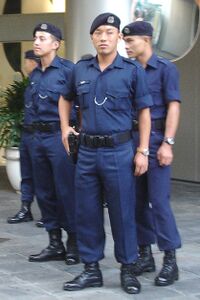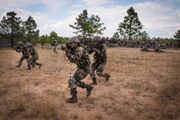Durkha
The Durkhas or Dorkhas (Mahanan: गोर्खा | Dōrkhā-), are soldiers native to Mahana renowned for their fighting prowess.
The Durkha units are composed of Mahanans and are recruited for several militaries around the world; The Mahanan Military, the Mekabirian army, the Namdatkan army and the Rhodellian army as well as being deployed for AN peacekeeping forces and in warzones around the wurld.
Origins
Historically, the term 'Durkha' and 'Dorkha' originate from the western regions of Mahana from the Khaddic Empire were the family of 'Durkarie' were hugely important advisors to the emperor. The Durkhas were initially a group of highly skilled and practised mercenaries and warrior monks that were hired by the Durkarie to protect them, giving them the name the 'Durkhas' or 'Dorkhas'. The name itself means ('Holy Protectors' or 'Pavitra Durkhā')
The Durkha military units are deployed around the world, notably in the Mekabirian amry, the Mahanan army itself and the Namdatkan army. They are also deployed as part of the AN peacekeeping forces.
The Durkha military are always associated with their important 'Kuhkiri', a traditional forward curving Mahanan blade. When describing the Durkha, Namdatkan Army Chief of Staff Field Marshall Palmo Jigme stated; "If a man says he is not afraid of dying, he is either lying or he is a Durkha."
Background
Earliest Forms
The earliest forms of the Durkha date back to the early Khaddic Empire were those who eventually came to be known as the Durkhas were a small, skilled and well known regional mercenary group for hire. They followed the principles of Gaism, however, which has remained a commonality in the regiments of Durkhas even until present day.
Before their official foundation, they are most well known for being hired by the emperor of the Khaddic Empire to protect the empire's top advisors and generals as well as the emperor himself. They got the earliest version of their name as a group when hired to defend the 'Durkarie' family of advisors, which is when they first became known as the 'Durkhas'.
After the collapse of the Khaddic Empire, the Durkhas existed in peace as the Mahanan government specifically passed a law to allow their work to continue, legally, as long as they could show proof of their allegiance to the Durkhas with their blade.
They spent a majority of this time working for free as warrior monks, protecting the Gai.
Official Foundation
The organisation was officially founded in 1763 as a branch in the Mahanan Army. They were payed extensively for their service as they were seen as essential during times of rising tensions in the region. About 10,000 Durkha fighters joined the army initially, with the rest seeing as their duty to stay and protect the religious leader of Gaism.
The Durkha were used in training the main branches of the military, with their own training sessions being far harsher than those of a normal soldier. It is said that if, upon inspection, the soldiers Kuhkiri was seen to be dirty or not in condition, the soldier would be removed.
Mahanan-Mekabirian War
The first conflict seen by the Durkhas was the Mahanan-Mekabirian War of 1791. The Durkhas played a huge part in the war, being decisive in battles such as the Battle of Bidakiye and the Battle of Six Waters. The soldiers impressed in the mountainous terrain, being able to easily adapt for any form of fight that occurred in the war, including firefights.
The war was the first time outside powers began to see the potential of hiring the Durkha soldiers for their own military operations, with many stories of the war and the Durkhas prowess travelling far beyond Orient.
Mahanan-Namdatkan Conflict
The second major conflict seen by the Durkhas was the Mahanan-Namdatkan War of 1813. Unlike the war against Mekabiri, the Durkhas were not deployed in such high quantities due to the use of modern technologies that the Durkhas were believed not to have adapted to at the beginning of the war, notably gunpowder.
Despite this, they were incorporated into the war efforts in 1815, using early gunpowder and previous techniques together in order to make a turning point in the war, although a white-peace was agreed with no clear winner as the war began to become detrimental for both sides. Historians argue that without the involvement of the Durkha it would have been a defeat for the Mahanan forces.
Subba Dictatorship
During the early 1900s, the Subba Dictatorship began to take power in an authoritarian dictatorship in Mahana, even overruling the power of the monarch. The Durkhas officially left the army in 1915, only four years after the Subba's rise to power. They left as response to the dictators rule, which the leader took as dissent.
It was also this time that the Durkha began to sell their services to other countries, beginning with neighbours Mekabiri. Mekabiri opened the 1st Durkha Regiment in 1922. Namdatka followed in 1929, with their military opening the Durkha Royal Regiment in the same year.
Upon the collapse of the Subba Dictatorship in 1943, some Durkha returned to the Royal Mahanan Durkha Regiment, however the numbers of returnees was still small initially. A majority of the Durkhas at the time, the mid-1940s, were believed to be serving abroad as well as in Mahana as religious soldiers to the Gai.
Mahanan Civil War
During the Mahanan Civil War of the 1990s, the army deployed the Durkhas as peacekeepers in major cities such as Jutpandi and Ghobari. The soldiers were seen as 'too harsh' in their techniques by the government and the Durkha were used to calm tensions within the major cities.
Modern Durkhas
In the modern day, Durkhas are deployed in multiple different militaries for multiple nations. The Durkhas command respect due to their historic and cultural prowess, representing Mahana at home and abroad were they serve.
Royal Mahanan Durkha Regiment
Durkhas still remain in Mahana, as an extension of the Mahanan Army. Now four regiments remain in Mahana;
- 1st Royal Durkha Regiment
- 2nd Royal Durkha Regiment
- 501st Gaian Durkha Regiment
- 502nd Gaian Durkha Regiment
Despite Mahana being the country of the Durkhas origin, they only have three regiments of active Durkhas in their army. However, it should be noted that Mahana is home to the Sukedhara Training Camp in Jutpandi, the world training headquarters for the Durkhas.
Mekabirian Army Durkhas
The highest foreign Durkha deployment is within Mekabiri, a neighbour of Mahana. The Durkha began being recruited by the Mekabirian Army in 1922 as they became avaliable to hire after leaving the Mahanan Army during the reign of the Subban Dictators. Since then, the Durkha have seen it as an honour to serve Mekabiri. In the present day 29 regiments exist in Mekabiri;
Major Divisions:
- 43rd Independent Durkha Infantry Brigade
- 26th Durkha Brigade
- 18th Durkha Division
- 48th Durkha Infantry Brigade
- 51st Durkha Infantry Brigade
As of August 2021, the following divisions are deployed in Mekabiri:
- 1st Battalion, The Royal Durkha Rifles (1RDR)
- 2nd Battalion, The Royal Durkha Rifles (2RDR)
- 3rd Battalion, The Royal Durkha Rifles (3RDR)
- 250 Durkha Signal Squadron, 30 Signal Regiment
- 246 Durkha Signal Squadron, 2 Signal Regiment
- 247 Durkha Signal Squadron, 16 Signal Regiment
- 248 Durkha Signal Squadron, 22 Signal Regiment
- 249 Durkha Signal Squadron, 3rd (Mekabiri) Division Signal Regiment
- 10 President's Own Durkha Logistic Regiment RLC
- President's Durkha Engineers, which includes:
- 58th Durkha Field Squadron, 36 Engineer Regiment
- 59th Durkha Field Squadron, 36 Engineer Regiment
- Durkha Staff and Personnel Support Company
- Band of the Brigade of Durkhas
- Durkha Company (Sittang), Free Military Academy
- Durkha Wing (Mandalay), Infantry Battle School
- Durkha Company (Tavoleto), Land Warfare Centre
The Brigade of Durkhas also has its own chefs posted among the above-mentioned units.
Rhodellian Durkhas
One of the highest recruiters of the Durkhas in modern day is Rhodellia, who historically were one of the earliest recruiters of the Durkha and a lot of Durkha remain in their army into modern day.
Royal Durkha Regiment (Namdatka)
Fighting Style and Combat
Other
Videos and Media








